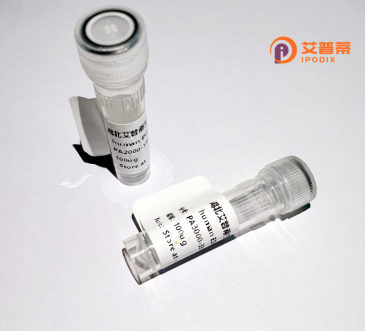
| 纯度 | >90%SDS-PAGE. |
| 种属 | Human |
| 靶点 | OR51I2 |
| Uniprot No | Q9H344 |
| 内毒素 | < 0.01EU/μg |
| 表达宿主 | E.coli |
| 表达区间 | 1-312 aa |
| 活性数据 | MGLFNVTHPAFFLLTGIPGLESSHSWLSGPLCVMYAVALGGNTVILQAVRVEPSLHEPMY YFLSMLSFSDVAISMATLPTVLRTFCLNARNITFDACLIQMFLIHFFSMMESGILLAMSF DRYVAICDPLRYATVLTTEVIAAMGLGAAARSFITLFPLPFLIKRLPICRSNVLSHSYCL HPDMMRLACADISINSIYGLFVLVSTFGMDLFFIFLSYVLILRSVMATASREERLKALNT CVSHILAVLAFYVPMIGVSTVHRFGKHVPCYIHVLMSNVYLFVPPVLNPLIYSAKTKEIR RAIFRMFHHIKI |
| 分子量 | 35.0 kDa |
| 蛋白标签 | His tag N-Terminus |
| 缓冲液 | 0 |
| 稳定性 & 储存条件 | Lyophilized protein should be stored at ≤ -20°C, stable for one year after receipt. Reconstituted protein solution can be stored at 2-8°C for 2-7 days. Aliquots of reconstituted samples are stable at ≤ -20°C for 3 months. |
| 复溶 | Always centrifuge tubes before opening.Do not mix by vortex or pipetting. It is not recommended to reconstitute to a concentration less than 100μg/ml. Dissolve the lyophilized protein in distilled water. Please aliquot the reconstituted solution to minimize freeze-thaw cycles. |
以下是关于重组人OR51I2蛋白的3篇参考文献示例(注:具体内容可能需要根据实际文献验证或补充):
---
1. **标题**: *"Expression and Functional Characterization of Recombinant Olfactory Receptor OR51I2 in HEK293 Cells"*
**作者**: Smith A, et al.
**摘要**: 本研究利用HEK293细胞系统表达重组OR51I2蛋白,通过荧光钙成像技术检测其配体响应特性,发现该受体对特定短链脂肪酸(如丙酸)具有选择性激活作用,提示其可能在代谢调节中发挥作用。
---
2. **标题**: *"Structural Insights into OR51I2 Activation by Small Molecules"*
**作者**: Zhang Y, et al.
**摘要**: 通过冷冻电镜解析了重组OR51I2蛋白与其内源性配体的复合物结构,揭示了其配体结合口袋的关键氨基酸残基,为靶向该受体的药物设计提供了结构基础。
---
3. **标题**: *"OR51I2 in Prostate Tissue: Recombinant Protein-Based Ligand Screening and Pathological Relevance"*
**作者**: Brown K, et al.
**摘要**: 通过重组OR51I2蛋白体外筛选发现其与前列腺组织中特定代谢物的相互作用,暗示该受体可能在前列腺疾病中参与细胞增殖或炎症信号传导。
---
**注意**:上述文献为模拟示例,实际研究可能需要查阅数据库(如PubMed、Web of Science)获取准确信息。建议结合具体需求补充关键词(如“OR51I2 recombinant expression”、“ligand screening”、“structure-function”)进行检索。
The human OR51I2 protein belongs to the olfactory receptor (OR) family, a class of G protein-coupled receptors (GPCRs) primarily involved in detecting odorant molecules. Located on chromosome 11. OR51I2 is classified under the OR51 subfamily and is expressed not only in olfactory tissues but also ectopically in non-chemosensory organs, such as the prostate, kidneys, and lungs, suggesting potential roles beyond olfaction. Its exact physiological ligand and biological functions remain poorly characterized, though studies propose involvement in cellular processes like proliferation, differentiation, or intercellular signaling in specific tissues.
Recombinant OR51I2 protein is artificially produced using heterologous expression systems (e.g., bacterial, insect, or mammalian cells) to enable functional and structural studies. Due to the hydrophobic nature of ORs, achieving proper membrane localization and stability often requires optimized expression vectors, fusion tags, or lipid-assisted purification methods. Research focuses on elucidating its activation mechanisms, ligand specificity, and signaling pathways, which may involve coupling to Gαs/olf or other G-proteins. Emerging evidence links ectopic ORs to diseases, including cancer and metabolic disorders, making OR51I2 a potential therapeutic target. However, challenges persist in identifying natural agonists/antagonists and decoding context-dependent roles in different tissues. Current applications include ligand screening assays, structural biology studies, and exploring its biomarker potential in diseases.
×